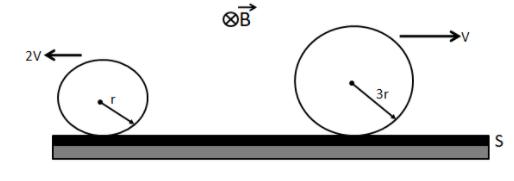Question
Question: Two conducting rings \[P\] and \[Q\] of radii \[r\] and \[3r\] move in opposite directions with velo...
Two conducting rings P and Q of radii r and 3r move in opposite directions with velocities and respectively on a conducting surfaceS . There is a uniform magnetic field of magnitude B perpendicular to the plane of the rings. The potential difference between the highest points of the two rings is:

A. Zero
B. 2 Brv
C. 6 Brv
D. 10 Brv
Solution
Note the direction of current for each of the loops and then find the highest and lowest potential points for each of the rings. Find the potential difference between the highest and lowest points for each of the rings from the given magnetic field and radius. The potential of the point on the surface is equal for both of the rings since they are in the same plane.
Find the potential difference between the highest points of the rings from each potential difference of these two rings.
Formula used:
If A is the highest potential point and E is the lowest potential point of the ring of radius r moving with a speed 2v,
The potential difference between two points, VAE=B(2r)(2v)
and, if C is the highest potential point and D is the lowest potential point, of the ring of radius 3r moving with a speed v,
The potential difference between two points, VCD=B(2×3r)(v)
Where, B is the magnetic field acting perpendicular to the plane of the rings.
The potential difference, V=VCD−(−VAE)=VCD+VAE
Complete step by step solution:
For the first ring, the direction of velocity is towards the left side. So if we apply Fleming’s right hand rule, the current is flowing from point A to E. Hence, A is the highest potential point and E is the lowest potential point of the ring.
Given, ris the radius of the ring and it is moving with a speed 2v
B is the magnetic field acting perpendicular to the plane of the rings.
∴ The potential difference between two points, VAE=B(2r)(2v)
⇒VAE=4Brv
For the second ring, the direction of velocity is towards the right side. So if we apply Fleming’s right-hand rule, the current is flowing from point C to D. Hence, C is the highest potential point and D is the lowest potential point Given, 3r is the radius of the ring and it is moving with a speed v
∴ The potential difference between two points, VCD=B(2×3r)(v)
⇒VCD=6Brv
The potential difference ,V=VCD−(−VAE)=VCD+VAE
∴V=6Brv+4Brv=10Brv .
Hence, the right answer is in option D. 10 Brv.
Note: The formula used for calculating the potential difference is coming from the equation of induced current in a straight conductor in motion, where the induced current I=RBlv, B is the magnetic field, v is the motion, l is the length of the straight conductor and R is the resistance.
⇒IR=Blv
⇒e=Blv
e is the electromotive force of the circuit, e=IR [Ohm’s law]
In the above problem, the length of the straight conductor l=2r i.e the length is equal to the diameter of the ring.
